生物显微镜水质检测:水中微生物和水藻的识别!
所属分类:国外显微镜实验攻略 点击次数:2004 发布日期:2022-05-29
通过在显微镜甚至放大镜下研究任何大小的有机体,肯定会有很多发现和乐趣。叶子的表面、黄蜂的头、蝴蝶翅膀上的鳞片,在今天与 16 世纪批显微镜使用者惊叹时一样令人惊叹。然后,当然,一些宏观生物具有微观部分或生命阶段——想想种子、孢子、卵和幼虫。
确实不乏主题:生活就在我们身边——我们只需要寻找它。微观生命,即大小小于 2 毫米的单细胞和多细胞生物,自然并不总是容易被发现——它可能是苔藓丛中的微小运动暗示,表明存在线虫或水熊虫。在其他情况下,带有浮游生物网的拖网可能会产生大量甲壳类幼虫或轮虫。
许多微生物具有水生习性,无论是淡水还是海洋。但这延伸到包括临时水坑和潮湿的苔藓、地衣或土壤。不要忘记,微观生命可以在其他生物和植物身上甚至内部找到。
所有的生物都可以活着研究。非常活跃的可能需要放在压缩器或活箱中,或以某种方式麻醉。有些需要作为载玻片准备保存和安装,以便充分辨别它们的结构,但有些则根本保存不好(例如一些原生动物和贝氏轮虫)。
浅尝辄止,对微观生活有普遍的兴趣,这不是罪过;对您的发现感到高兴——无论是通过现场收集还是通过购买准备好的幻灯片。但是,您可能会发现自己被一个或多个特定的有机体群体所吸引,并希望深入研究它们。事实上,业余专家可以为科学知识做出宝贵贡献(许多例子可以在Quekett Journal of Microscopy的页面中找到)。只需从一个地方发送定期的生物记录,就可以帮助增加对记录不足的群体的了解。请联系您当地的野生动物信托基金或当地记录中心寻求建议。显然发现需要准确识别,有些物种比其他物种更容易识别!– 但通常有专家,无论是在俱乐部内还是在自然历史博物馆的 NaturePlus ( www.nhm.ac.uk/natureplus/community/identification ) 或 iSpot ( www.ispot.org.uk )等网站上在线愿意帮助验证。当然,也有许多参考书和识别指南可供使用——俱乐部的图书馆有很多可供选择。
这里只是一小部分微生物的选择:
原生生物或原生动物是在各种栖息地中发现的单细胞生物,但主要与水生环境有关,从淡水池塘和海洋,到许多昆虫和哺乳动物的胃,它们对食物的分解至关重要。原生细胞很容易在复合光学显微镜下研究,并显示出惊人的结构多样性;有几本好书可以让初学者开始研究和识别原生动物。
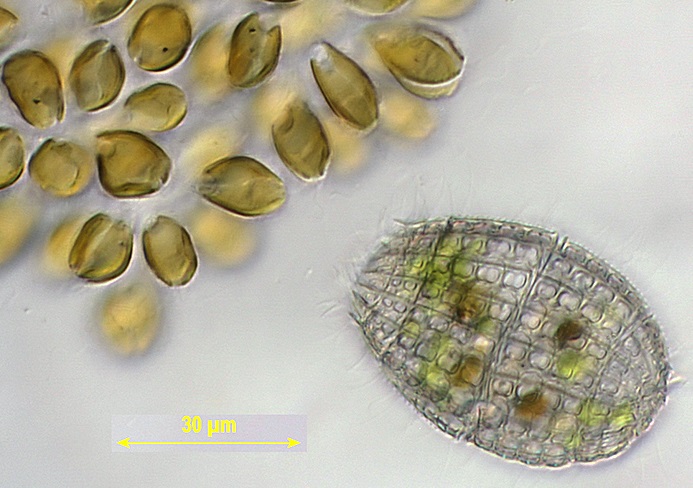
Coleps sp.
一些最美丽的微生物是藻类,它们以多细胞“链”(如水绵)或单细胞形式出现。
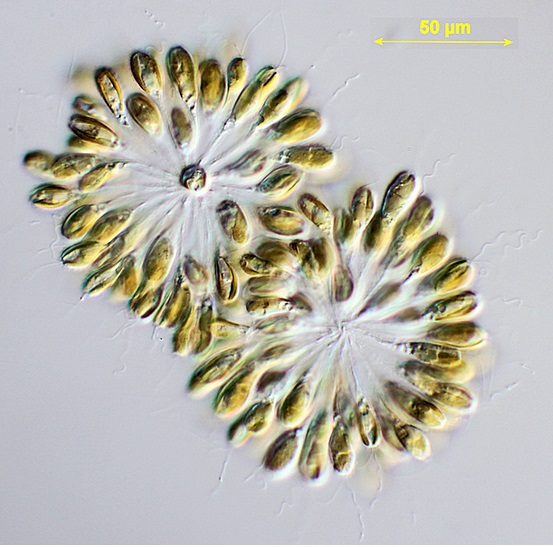
Synura sp., a colonal alga
两个最有趣的群体是硅藻和海藻。硅藻是一种单细胞藻类,会分泌出复杂的二氧化硅壳,这些二氧化硅壳在细胞死亡后仍能存活很长时间。自维多利亚时代(当它们用于测试显微镜物镜的质量时)以来,这些精美的箱子一直是显微镜学家最喜欢的主题,而 Quekett 俱乐部有许多专门研究硅藻的专家。
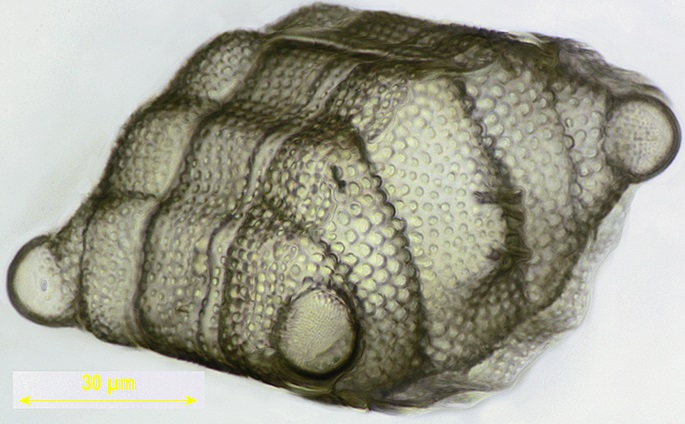
Biddulphia sp.,一种来自毛里求斯的硅藻
Desmids是横向对称的单细胞绿藻,广泛分布于淡水中;他们再次吸引了一群敬业的专家。
在动物群中,轮虫最初被称为“轮状动物”,因为它们的纤毛(毛发)冠部齐声跳动,看起来像轮子一样旋转。轮虫是多细胞的,具有简单的器官,但存在于多种体型中;它们可以在淡水和苔藓等其他潮湿环境中找到。
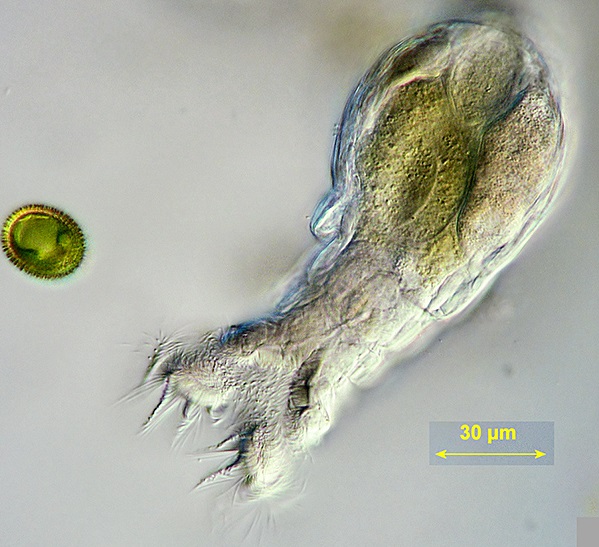
贝氏轮虫
Quekett 的一名成员专门研究bdelloid 轮虫。
与在世界范围内拥有许多专业工作者的轮虫不同,全球可能只有不到 10 人(专业人士或业余人士)研究胃蜈蚣(或“毛胃”),因此为发现新物种提供了机会。它们存在于水环境的泥浆和沉积物中,尤其是池塘。
水熊虫或缓步动物是一个神秘的群体,具有蠕虫(蠕虫状)和节肢动物的特征,因此被置于各自独立的门中。从外观上看,它们看起来像小蛞蝓,但有四对粗短的腿,长着爪子,通常有眼点和独特的刺口装置,它们用来从苔藓细胞中获取食物或放牧细菌。已知的物种超过 1,000 种,它们分布在世界各地的苔藓、地衣和沉积物中。
任何仔细观察过池塘水的人,即使是用肉眼,都会熟悉桡足类和枝角类,这两个主要的“微观”甲壳类动物群。桡足类,其中独眼巨人是一个众所周知的例子,是精力充沛的游泳者,而枝角类,如水蚤,具有较慢的跳蚤般的游泳运动,因此它们的共同名称是水蚤。这两个组对于业余爱好者来说都很容易工作,有许多识别键可用。
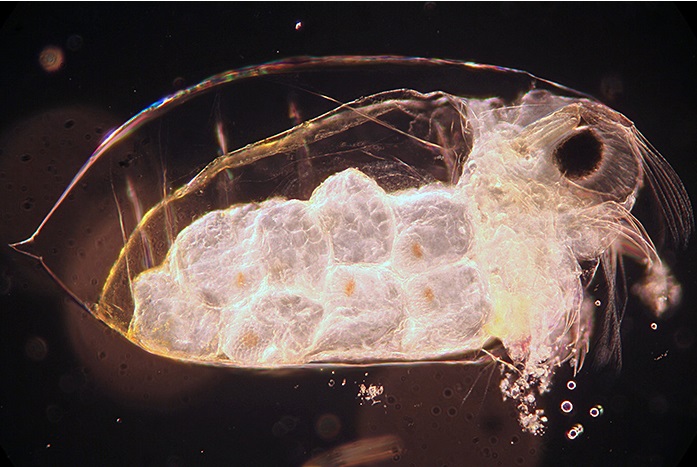 Evadne sp. (Cladocera)
Evadne sp. (Cladocera)
水蚤属 (Cladocera)
点击左下角的箭头观看视频(14秒)
苔藓动物或苔藓动物是使用它们的触须捕捉水中的食物颗粒的殖民地动物。它们生活在淡水和海洋栖息地,附着在岩石、木材和藻类等基质上。
There is certainly much to discover and to delight in through investigating any organism, of whatever size, under a microscope, or even a magnifying glass. The surface of a leaf, the head of a wasp, scales on a butterfly wing, are just as amazing today as when they were marvelled at by the first users of microscopes in the sixteenth century. Then, of course, some macroscopic organisms have microscopic parts or life stages – think of seeds, spores, eggs and larvae.
There really is no shortage of subjects: life is all around us – we just have to look for it. Microscopic life, that is single and multi-celled organisms under about 2 mm in size, is naturally not always easy to spot – it may be a tiny hint of movement in a clump of moss that reveals the presence of a nematode or water bear. In other cases a trawl with a plankton net may yield up a teaming mass of crustacean larvae or rotifers.
Many microscopic organisms have an aquatic habit, either freshwater or marine. But this extends to include temporary puddles and damp moss, lichen or soil. Don’t forget that microscopic life can be found on or even inside other creatures and plants.
All of the organisms can be studied alive. Very active ones may need to be held in a compressorium or live box, or anaesthetised in some way. Some will need to be preserved and mounted as slide preparations in order to fully discern their structure but some will not preserve at all well (e.g. some Protozoa and bdelloid rotifers).
It is no sin to be a dabbler and take a general interest in microscopic life; delighting in finds that come your way – either from field collecting or through purchasing prepared slides. However, you may find that you are attracted to a particular group, or groups, of organism and wish to study them in some depth. It is a fact that amateur experts can make valuable contributions to scientific knowledge (and many examples can be found in the pages of the Quekett Journal of Microscopy). Simply by sending in periodic records of organisms from a single locality can help increase knowledge of under-recorded groups. Contact your local Wildlife Trust or Local Record Centre for advice. Obviously finds need to be accurately identified and some species will be easier to identify than others! – but there are usually experts, either within the Club or online on such sites as NaturePlus at the Natural History Museum (www.nhm.ac.uk/natureplus/community/identification) or iSpot (www.ispot.org.uk) who are willing to help with verification. Of course there are also many reference books and identification guides available – The Club’s library has a good selection.
Here is just a small selection of microscopic organisms:
Protists, or Protozoa, are single-celled organisms found in a variety of habitats but principally associated with aquatic environments, from freshwater ponds and the sea, through to the stomachs of many insects and mammals where they are essential to the breakdown of foods. Protist cells are easily studied under compound light microscopes and show an amazing diversity of structure; several good books are available to get the beginner started in studying and identifying Protozoa.
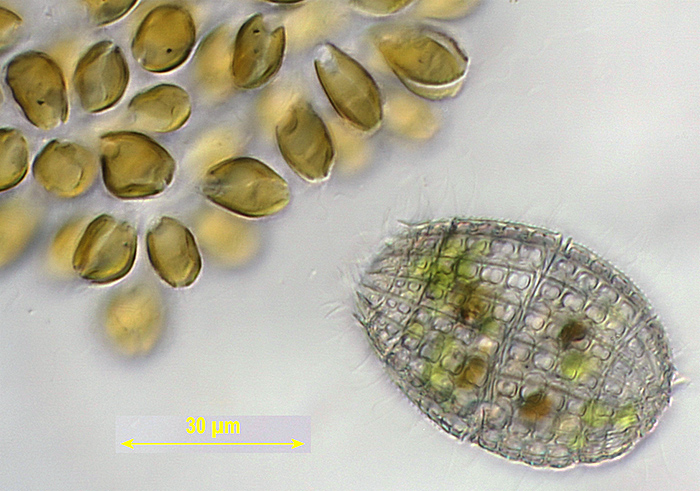
Coleps sp.
Some of the most beautiful microscopic organisms are algae, which occur as both multi-celled ‘strands’ such as Spirogyra, or as single cells.
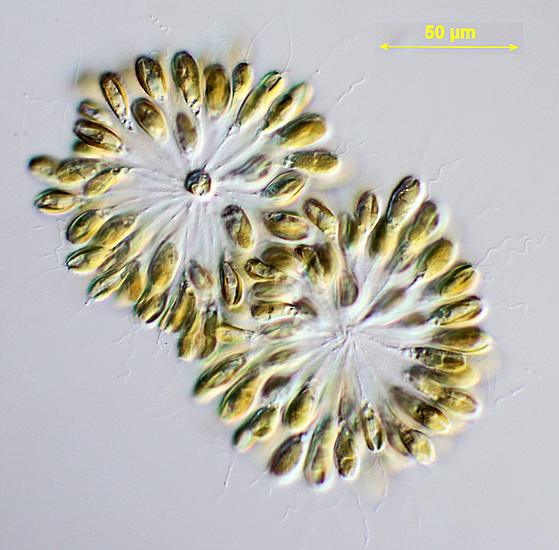
Synura sp., a colonal alga
Two of the most interesting groups are the diatoms and the desmids. Diatoms are single-celled algae that secrete intricate silica cases which survive long after the cell has died. These exquisite cases have been a favourite subject for microscopists since Victorian times (when they were first used to test the quality of microscope objectives), and the Quekett Club has many specialists who work exclusively on diatoms.
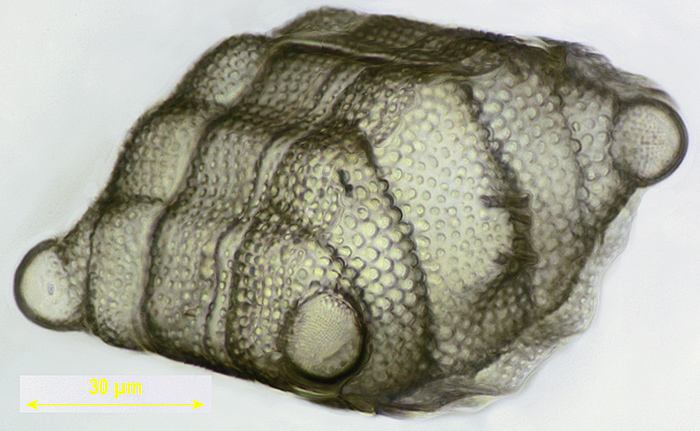
Biddulphia sp., a diatom from Mauritius
Desmids are single-celled green algae that are laterally symmetrical and widely distributed in fresh waters; again they attract a dedicated band of specialists.
Amongst the animal groups, the rotifers were originally called ‘wheel animalcules’ due to their crown of cilia (hairs) that beat in unison and appear to be rotating like a wheel. Rotifers are multi-cellular with simple organs but occur in a wide range of body shapes; they can be found in freshwater and other damp environments like mosses.
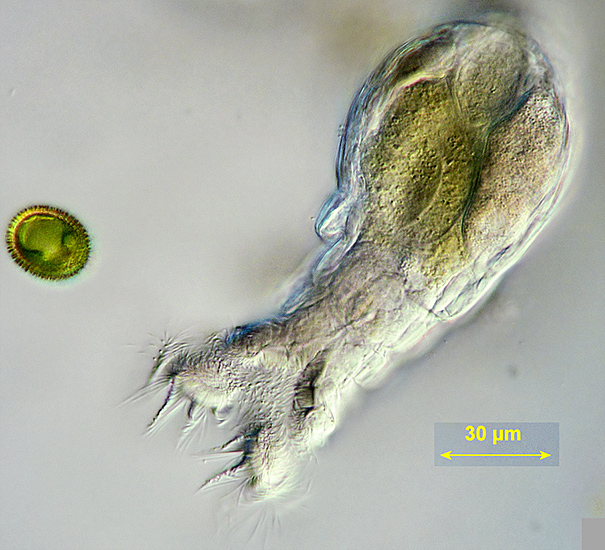
A bdelloid rotifer
One member of the Quekett specialises in bdelloid rotifers.
Unlike the rotifers which have many specialist workers worldwide, gastrotrichs (or ‘hairy stomachs’) are studied by perhaps less than 10 people (professional or amateur) worldwide and thus provide great opportunity for new species to be discovered. They occur in the muds and sediments of aqueous environments, and ponds in particular.
The water bears, or tardigrades, are an enigmatic group that possess both helminth (worm-like) and arthropod characteristics and have consequently been placed in their own separate phylum. In appearance, they look like small slugs but have four pairs of stumpy legs bearing claws, often eyespots and a distinctive piercing mouth apparatus which they use to feed from moss cells or graze bacteria. Over 1,000 species are known, and they occur worldwide in mosses, lichens and sediments.
Anyone who has looked closely at pond water, even with the naked eye, will be familiar with the copepods and Cladocera, two of the main ‘microscopic’ crustacean groups. The copepods, of which Cyclops is a well-known example, are energetic swimmers whilst the Cladocera, such as Daphnia, have a slower flea-like swimming motion hence their common name of water-fleas. Both groups are easy for the amateur to work on, with a number of identification keys available.
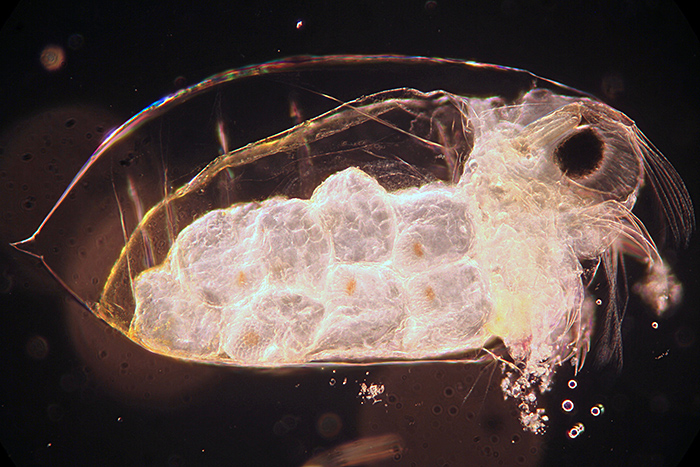
Evadne sp. (Cladocera)
Daphnia sp. (Cladocera)
Click the arrow at bottom left to watch the video (14 seconds)
Bryozoans, or moss animals, are colonial animals that use their tentacles to catch food particles in water. They live in freshwater and marine habitats, attached to substrates such as rocks, timber and algae.
Video of freshwater bryozoans [by Tony Pattinson]
Click the arrow key to start the video; click the icon to the left of “vimeo” to see a full-screen version
网站网友点击量更高的文献目录排行榜:
关注页面底部公众号,开通以下权限:
一、获得问题咨询权限。
二、获得工程师维修技术指导。
三、获得软件工程师在线指导
toupview,imageview,OLD-SG等软件技术支持。
四、请使用微信扫描首页底部官主账号!
相关新闻
- 体视显微镜下:蝌蚪虾的临时坐骑 [2022-05-29]
- 体视显微镜下:火柴头上的虫子 [2022-05-29]
- 复合显微镜、高倍显微镜 [2022-05-29]
- 体视显微镜的原理 [2022-05-29]
- 生物显微镜水质检测:贝氏轮虫 An introduction to bdelloid rotifers and their study [2022-05-29]
- 生物显微镜水质检测:水中微生物和水藻的识别! [2022-05-29]








